|
from
EvolutionNews Website Image credit:
Penn State (cropped).
For example, think of how difficult it would be to design a nano air vehicle (NAV) that could flip over and land feet up on a glass ceiling.
Scientists who look more closely at these things often stand in awe of what animals do.
Here are some small wonders that deserve our admiration and respect.
The Fly
Scientists from the U.S. and India slowed down and magnified how flies could land on a ceiling.
In their paper "Flies Land Upside-down on a Ceiling using Rapid Visually mediated Rotational Maneuvers," published in the AAAS open-access journal Science Advances, they share what they learned.
Penn State researchers, who participated in the study, call this,
Lead author Bo Cheng said,
The team was astonished to see how the fly could achieve four "perfectly timed maneuvers" to land upside down in the blink of an eye: acceleration, cartwheel, leg extension, and whole-body swing assisted by the legs.
The fly's maneuvers "exhibited remarkably high angular velocity," the scientists found, as they watched how the small insect "cartwheels" around its forelegs.
Its body comes well equipped to handle the strain.
The research team was apparently too fascinated with the aerodynamics to speculate about evolution.
A fly is also well-equipped for stable flying.
Michael Dickinson has been studying insect flight for years in his specialized lab at Caltech. His team published another "remarkable" paper in Current Biology, reporting that "Flies Regulate Wing Motion via Active Control of a Dual-Function Gyroscope."
Fruit flies are members of Diptera (two-wing), because their shriveled-up hind wings, called halteres, have been considered vestigial flight wings.
Some have thought they function as gyroscopes.
Dickinson decided to test that idea:
Evolutionists who have treated halteres as useless vestigial organs are now going to have to explain even more function than previously thought.
But if the halteres serve useful timing and control functions now, who is to say they were not original equipment? After all, dipterans in general are among the most versatile flyers in the insect world.
If something works, as Paul Nelson has pointed out, it's not happening by accident.
Compared with other insects with four wings, flies have this advantage:
At best, the benefit can be seen as subfunctionalization of working hindwings. That would represent an example of devolution, not evolution of new functional traits.
Like a driver low on gas, he eliminated the trunk to get better gas mileage.
Rapid Antics
A new land speed record has been discovered in ants.
New Scientist writes,
Reporter Michael Marshall doesn't say if the ant cries "Ouch!" at every footstep on the hot Sahara sand, but this ant looks like a blur as it runs, imitating the Road Runner of cartoon fame.
The ant's trick is to synchronize all six legs and take up to 47 steps per second.
Hunting for heat-exhausted insects in the daytime, the Saharan silver ant has another adaptation:
Nature's coverage (A Land-speed Record for Ants set in Saharan Dunes) includes a video showing the ant's running technique slowed down by a factor of 44... and that is still almost too quick to concentrate on.
Galloping at 85 centimeters per second, the ant practically flies with all its feet off the ground at some points in its gait. Touching down with three feet on the ground at a time also gives it stability, like a tripod, that helps keep the ant from sinking into the sand.
Burrow Masters
NASA's engineers are trying to solve a problem with their newest lander on Mars, named 'Insight.'
Its "mole," an instrument designed to burrow 16 feet into the Martian soil to measure Marsquakes, is stuck at 14 inches. It was equipped with an inertial hammer for digging, but the soil is proving harder than expected, JPL says.
Perhaps they should have mimicked earthworms instead.
How do soft, squishy animals manage to loosen the soil so effectively?
Helen Briggs of BBC News reports that,
The atlas of global earthworm diversity, published by the AAAS (Global Distribution of Earthworm Diversity) in Science, begins by explaining why this is important.
Separately, Liu et al. in Current Biology (Earthworms Coordinate Soil Biota to Improve Multiple Ecosystem Functions) investigated how,
Their key concept was "multifunctionality" of soils, which refers to,
Their experiments and observations showed that worms offer their vital contribution primarily by,
Less important were their effects on soil structure and pH.
In other words,
One cubic meter of soil can contain 150 individual earthworms, the BBC says.
These papers don't get into that, but suffice it to say, without them, Earth soil would likely be as inhospitable as that on Mars.
A Dynamic Planet
At many levels, our privileged planet was designed with the foresight to promote habitability.
Environments on a dynamic planet are likely to change. When the habitat changes, organisms must be flexible enough to adapt. Intelligent design theory can support diversification, the "lawn" of life branching at the tips, instead of Darwin's tree with a single root.
The silver Sahara ant, for instance, could have diversified from other ants once the Sahara dried up from its former riparian habitat (as evidenced by river channels detectable under the sand).
It would only require modifications or exaggerations of existing traits:
There are some 6,000 species of earthworms, including species just a few centimeters in length to giants as long as 3 meters; these also could have diversified based on their local environments.
A fly's hind wings could shrink and degrade if the wings subfunctionalized, moving from multiple purposes to focus on the most important for its needs.
This is not too different from blind cave fish that, having lost eyes, compensate with exaggerated senses of touch and smell. None of these considerations affect the argument from design.
We can marvel at the foresight built into these creatures that become champions at particular traits in their respective family contests.
|


